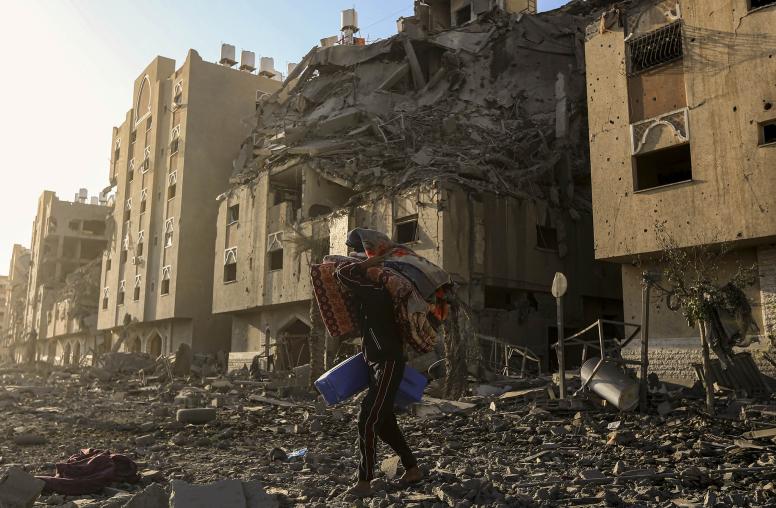
A poll conducted in partnership with the U.S. Institute of Peace provides some illuminating insights. The results and accompanying report were released by the Anwar Sadat Chair for Peace and Development and the Program for Public Consultation at the University of Maryland on Dec. 6, and it is easy to focus on the responses that reflect the shared cynicism and pessimism of Palestinians and Israelis towards the current negotiations.
The survey found that 47 percent of Palestinians and 48 percent of Israelis do not believe that a peace agreement will ever be reached. Only 4 percent of Israelis and 11 percent of Palestinians said they believe a peace agreement will be reached in the next year.
But a deeper dive into this survey reveals a more complex picture that suggests some room for hope, and points the way to how the two sides may yet be able to get to a deal. To conduct the research, a Palestinian polling firm questioned 1,003 Palestinians face-to-face between Nov. 17-28, for a margin of error of plus or minus 3.2 percent. An Israeli firm queried 1,053 Israeli Jews and Arabs on Nov. 21-25, face-to-face and via the Internet, with a margin of error of plus or minus 3 percent. The primary investigators were Shibley Telhami, the Sadat professor at the University of Maryland, and Steven Kull, senior research scholar at the university’s Center for International and Security Studies.
The real headline derives from the answers elicited when respondents were presented with the outlines of a detailed package on final status: one that reflected the components that, over the years, experts have coalesced around as likely elements of a deal.
Support for such an agreement improved with the assurance that the other side would sign on. Among those respondents who initially recommended rejection of such a package deal, 10 percent of the Israelis and 20 percent of the Palestinians shifted their position when presented with the scenario that the other side would accept it. In other words, 60 percent of respondents on each side supported the agreement when they heard that the other side was prepared to do the same.
There are two broad lessons to be derived from this finding: 1) Public opinion is dynamic, and can be moved. 2) In the case of the current peace process, the key drivers for shifting the dial in the direction of an agreement is the prospect of success which, in turn, is contingent upon proof of buy-in from the other side. This also confirms what is apparent to anyone who has spent time on the ground in Israel and Palestine recently: that the overarching pessimism towards peace is grounded in deep mutual distrust.
The challenge is certainly daunting: building trust that has eroded over decades is a long-term proposition that seems at odds with a negotiations time-frame that is just four months shy of its initially-conceived expiration. But it is key to distinguish between the level of trust needed to reach an agreement, and the ongoing process of trust-building that will be required to implement and sustain that agreement.
This contrast is underscored by the fact that the numbers in support of an agreement exist alongside a finding that 62 percent of Palestinians and 51 percent of Israelis prefer a post-agreement reality in which “interactions with the other side are kept to a minimum [and] limited to necessary…functional tasks.”
In other words, reaching a deal is not necessarily premised on rapprochement and reconciliation. In fact, additional poll findings underscore that the publics will get on board with a deal that, while less than ideal, is deemed to be an acceptable alternative to what non-agreement might bring. Despite deep reservations on the part of both the Palestinians and the Israelis to the package deal presented, with buy-in from the other side assured, it won out over any other alternative to a two-state solution that either side could imagine.
If reaching a deal is contingent upon both sides believing that success is a possibility, it will require heavy lifting by a combination of the Israeli and Palestinian leaderships, the networks of Israeli and Palestinian civil society actors on the ground who already put faith in and actively work toward bringing about a peace agreement, and also by the U.S. in its role as facilitator of this process.
By way of broad prescription, it will require mobilizing supporters at the same time as it requires engaging dissenters. It will require the leaders to pull back on the negative messaging about the other side that currently dominates the few headlines there are about the process, and to replace them with statements that suggest faith in the process, and in each other as a partner. Finally, it will require the U.S. and other international actors to play an active role in enabling positive developments on the ground and fostering conditions conducive to the leaders taking bold steps in support of peace. Such steps might include a combination of security and economic measures and assurances that allow the two sides to envision a secure and prosperous future alongside each other.
This is a weighty list of requirements, and each one is deserving of full-fledged analysis. But the broader point here is to urge a departure from the apathy and fatalism that tends to accompany the release of polls that point to pessimism around the peace process and, instead, to consider the proactive ways in which the many relevant stakeholders can affect the outcome. At the outset of these negotiations, Secretary Kerry stated that “failure is not an option.” While this poll suggests that time may yet tell, it also tells us that failure is far from a foregone conclusion.
Lucy Kurtzer-Ellenbogen is USIP’s director of Arab-Israeli programs.



